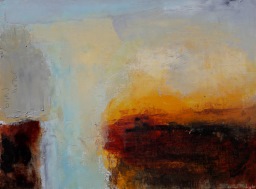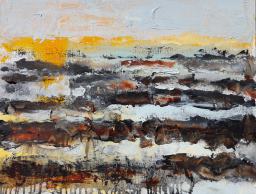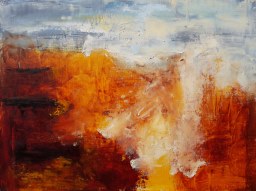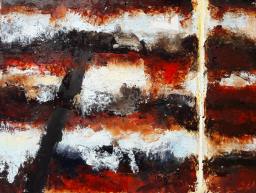The Harp is the national emblem, and has been played for over 800 years in Ireland, and yet it died out after the 1800s so that now there are only 16-18 original Harps left in Ireland.
As Siobhán Armstrong explains, in Irish Harp Music there were three types of music:
- Geantraí (lively dance music)
- Goltraí (sad music)
- Suantraí (lullabies)
We have to ask ourselves, why would a people want to listen to sad? We can identify with Geantraí, (lively dance music) as it ties more closely in with our ideas of art as entertainment. But Goltraí, music to make you cry? Why would people want to listen to sad music? I think the answer lies in the fact that if we're already experiencing some tragedy then music, actually opens us up to the universality of our suffering. This is the transcendant aspect of art that allows us to break our separateness from each other and reveal to us our deep connections with the human experience. Perhaps this is why the anciet gaels listened to sad music. We have the laments, the Cumha that are a feature of this music, usually laments for a person now deceased.
Gaelic culture once stretched from Ireland to the Highlands and western Isles of Scotland, making one Gaelic nation, which shared syllabic bardic poetry, language, music and the Harp.
The oldest vernacular literature in Europe is Irish.
In the Irish Court, in first place was the King, in 2nd was the poet and in 3rd was the Harper.
Click here for a YouTube talk on the subject that Siobhán gave in Galway in 2015
Click Here for the Historical Harp Society Of Ireland Website
There were great movements of people and families between Ireland and Scotland.
In the 17th century colonial expansion took hold having begun in the 16th century with the Elizabethan conquests. These conquests have been termed colonial capitalism, because the crown used private armies, termed "adventurers" to fight the war against the Irish. Payment would be made when the war was over and would be in the form of land granted to them which had previously been owned by the Irish catholics who were now dispossessed. This campaign culminated in the Down Survey.
The armies of the English Commonwealth, commanded by Oliver Cromwell, emerged victorious and immediately undertook an ambitious project of social engineering, underpinned by a massive transfer in landownership from Irish Catholics to English Protestants. For this to happen, the land had to be accurately surveyed and mapped, a task overseen by the surgeon-general of the English army, William Petty.
Taken in the years 1656-1658, the Down Survey of Ireland was the first ever detailed land survey on a national scale anywhere in the world. The survey sought to measure all the land to be forfeited by the Catholic Irish in order to facilitate its redistribution to Merchant Adventurers and English soldiers. http://downsurvey.tcd.ie/
This caused a huge disruption to life; constant war and famine started to weaken Gaelic society in the 16th century and this continued into the 17th century. The patronage of the Harpers started to suffer and decline from its heyday in the 15th and 16th centuries. By the 18th century the Harpers were now itinerant, staying a week or a month in a great house of the new anglo Irish ascendancy, and the amount of land in catholic ownership fell to only 3% of the total.
The work in this show is a reaction to the music of the historical Irish Harp. During its creation I immersed myself in this music. It's also a reflection on the story of the Harp and Harpers from its prime where in the Gaelic system the Harper was a high status figure, to its steady decline as the Gaelic order collapsed. There's a poignancy to the fact that the grandchildren of the high status harpers became itinerant players going from patron to patron.
In terms of visual motifs we see horizontal lines like furrows in the ground. They could be potato drills, or turf bogs scarred from digging. Remote mountain lands spreading out into the distance away from the roads.
Or roads carved through the landscape, or super-imposed on it, and we think of the travelling harper, poorer than his grandparents and relying on the favours of landowners, as the relentless march of progress made useless all of the things they'd held dear. Their values and value systems were simply no longer relevant.
I began using these linear themes, horizontal lines and writing. Writing made me reflect on the fact that many of the Harpers couldn't read or write. In terms of visual motifs I began using a linear counterpoint; this could have been a road across a bleak landscape. A country ravaged by forced famines and appropriated lands. A place that looked "not only like a desert, but like hell, if hell could exist on earth" -Owen Roe O'Neill.
I began to reflect on how straight lines and colonialism went hand in hand. How poorer people couldn't use the technology that the colonist could and therefore they were at a disadvantage. How the line was imposed upon the landscape, but how the crooked line of the land could overcome the straight line of the planner, the surveyor, the settler, the rule maker.
It was in this climate that the last Harpers existed. The Gaelic order had fallen and there were no more great houses to act as patrons for Harp music. A way of life was fast disappearing. Musical laments were written, or Cumha in Irish. Thus the decline of the harp becomes a metaphor for the fragility of culture. And yet, there's a resistance. A tender and fragile act of going against the grain. Despite the relentless grinding out of a new pathway there's a sense that underneath everything there's a richer and deeper pool that can't be fathomed. That gift that keeps on giving, is what Gaelic culture turned out to be. Somehow in their weakness they were still able to go back to this common pool and not only draw from it, but to replenish it with new sustenance. And here is the fragile line appearing. Not being superimposed but being revealed as a way of carrying on regardless of intentional ideas, and running on anyway like an underground river finding its path.
How there's a redemptive force in all nature and that's what Irish culture was able to tap into to help it sustain itself.














